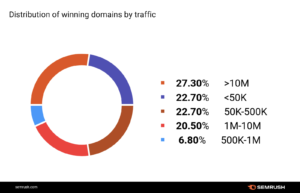Roughly twice a year, Google announces a core update that stirs the SEO world. And, for good reason! Google remains the core driver of organic search results. They are the ball game if you want to find new customers and/or allow existing customers to find you. Although Google continuously tweaks their 800 pound gorilla of an algorithm, major changes are reserved for these special core updates. SEO experts have a spidy sense that core updates are coming and they generally scour the web to learn about subtle hints from Google in advance of the changes. However, for the most part, the crux of recent Google core updates focus on usability and the mobile experience.
For example, the BERT update in October 2019 focused on neural networks that helped computers think like a human.
“Google notes the breakthrough derived from research on transformers, which enabled the algorithm to process words in a sentence. Conversely, prior to the BERT update, the algorithm processed words individually. As a result of BERT, the algorithm now contains the ability to process the context and intent of a search query.”
Ultimately, the BERT update impacted about 10% of search queries that were mainly related to long-tail keywords. However, the focus was improving search results for people using voice search and/or searching for terms like they speak.
Prior to the BERT update, there was the Favicon update that applied design changes (previously applied to mobile) to desktop search results. The update allowed focused on enhanced understanding of the source of the search result. In essence, the Favicon update increased the brand exposure (by including its icon) when their site showed in results. Although the update had some controversy, it aligned with user sentiment.
So, as we move into 2021, SEO experts are exploring the impact of the December 2020 Core Update and pending May 2021 Core Update.
December 2020 Core Update
Google released a classic broad core update on December 3, 2020 (aka the December 2020 Core Update). Like previous broad-based core updates, this was a global update that had an across the board impact. According to SEMRush, along with other data providers, this was a pretty significant core update that impacted most sectors (and much larger than the previous broad update in May 2020).
“Multiple sectors seem to be affected this time. On December 4, the second day of the roll-out, SERPs for most site categories reached a 9.4 volatility mark (and all of them presented volatility above 9), even SERPs that on the first day of the update seemed to be relatively unaffected by it like Books & Literature and Real Estate. Even “green zone” categories (industries that rarely experience any noticeable volatility outside a broad algorithm update) this time shook hard.”
Although every industry was affected, (and companies) generally business, internet and beauty/fitness sites fared pretty well. Conversely, online communities, shopping and news sites fared worse. Based on recent search history (derived from the coronavirus pandemic), the sectors that experienced increases and decreases align with the last year of internet history. Generally, sites and sectors benefited from increased search volume to find more information during COVID, which likely explains the positive impact of the update (and corresponding increase in SERP rankings). While, the sites that experienced decreased search volume suffered from some search migration and/or lost some tarnish on their reputations.
Additionally, not only did the December 2020 Core Update impact most (if not all) sectors, but it also affected a large range of sites.

Based on SEMRush analysis, roughly 50% of the impact was split between sites with over 10 million monthly visitors and sites with less than 50,000 monthly visitors. The sweet spot of limited impact were mid to large sites between 500,000 to 1 million monthly visitors.
How to address the core update
As with all other core updates, Google’s advice remains consistent:
- Invest in creating high-quality content that follows best-in-class industry practices;
- Make use of structured data to help search engines uncover the most relevant content per search query; and
- Fix any SEO issues that hinder smooth user experience.
Finally, as SEO experts dig out of the holiday season and started implementing 2021 strategies, Google announced a new core update in May. So, if you and your team suffered from the December 2020 update, then focus on fixing the major issues identified in a site audit and attempt to address items that will likely be included in the May core update.
May 2021 Core Update on the Horizon
Google announced another core update in May 2021 aka Core Web Vitals update, which is always a gift and a curse. The SEO world definitely appreciates the heads up about major core changes, but also feels a little cloud over their collective heads as the data approaches. Fortunately, with a few months of advanced warning, SEO experts can collect their thoughts and establish a plan to address the probable core updates that always revolve around the user.
There are a few main aspects of the May 2021 update, including a focus on core web vitals and the page experience signals on mobile. To Google, these components highlighted in the Core Web Vitals are user metrics that help companies understand (and ultimately improve) the user experience of their site.
“User-centric metrics are a critical tool in understanding, measuring and improving the user experience of your website. Largest Contentful Paint measures how quickly users see content. First Input Delay measures how responsive a site is to user input like tapping a button or entering data in a form. Cumulative Layout Shift measures how often elements of the page move around while the user is trying to read or interact with it.”
Google constantly prioritizes the observed user experience above all else (with the probable exception of quality content on the page that aligns with the user search intent). However, from a technical perspective, how the content renders will increasingly become more important.
How to address the core update
Additionally, the focus on mobile page experience continues to support the importance of the mobile search experience. As Search Engine Land notes, Google is not taking mobile lightly and depending on your industry, you should not either!
“Google will even begin testing a visual indicator in the search results to highlight pages that provide a great user experience. For businesses in highly competitive sectors where having quality content is table stakes, improving your user experience ahead of the update may provide you with an advantage in the rankings.”
Fortunately, the May 2021 update does not appear like a significant broad-based core update, but rather focused on the areas Google outlined. To help, Google reiterated that sites leveraging AMP should meet the new UI thresholds. However, if your site is not on AMP, then Google published a list of FAQs around Core Web Vitals that you and your dev team should review. Plus, the FAQ includes more information around the page experience update, along with performance metrics pertaining to user experience that every SEO team should read.




